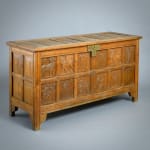














EXCEPTIONAL ARTS & CRAFTS OAK COFFER DESIGNED BY HENRY WILSON
Further images
-
(View a larger image of thumbnail 1
)

-
(View a larger image of thumbnail 2
)

-
(View a larger image of thumbnail 3
)

-
(View a larger image of thumbnail 4
)

-
(View a larger image of thumbnail 5
)

-
(View a larger image of thumbnail 6
)

-
(View a larger image of thumbnail 7
)

-
(View a larger image of thumbnail 8
)

-
(View a larger image of thumbnail 9
)

-
(View a larger image of thumbnail 10
)

-
(View a larger image of thumbnail 11
)

-
(View a larger image of thumbnail 12
)

-
(View a larger image of thumbnail 13
)

-
(View a larger image of thumbnail 14
)

-
(View a larger image of thumbnail 15
)

AN EXCEPTIONAL ARTS & CRAFTS OAK COFFER DESIGNED BY HENRY WILSON (1864-1934) AND MADE BY W.E. MICKLEWRIGHT, CIRCA 1923.
Carved with the twelve signs of the zodiac.
33in. (84cm) high; 64in. (163cm) wide; 23.5in. (60cm) deep.
The Arts and Crafts architect and designer Henry Wilson trained under J.D. Sedding (1838-1891). In addition to his architectural commissions, Wilson increasingly worked as a designer of metalwork, sculpture and jewellery and became a leading member of the Arts and Crafts movement. In 1905 he designed the bronze doors for the cathedral of St. John the Divine in New York. He was president of the Arts and Crafts Exhibition Society from 1915-1922 and became Master of the Art Workers Guild in 1917.
The workshop responsible for executing Wilson’s woodwork designs was Charles Trask & Sons of Norton-sub-Hamdon in Somerset. W.E. Micklewright was manager and latterly owner of the workshop until its closure in 1925. An identical coffer was illustrated in The Studio in 1923 and is now in the John Getty Collection.
Literature
An identical coffer exhibited at the British Institute of Industrial Art in 1923, is illustrated in The Studio, vol 86 1923, p. 265.